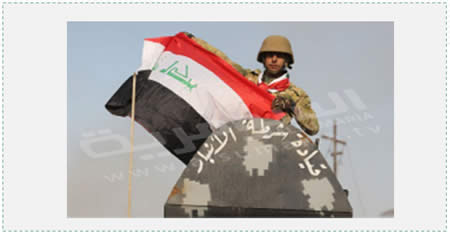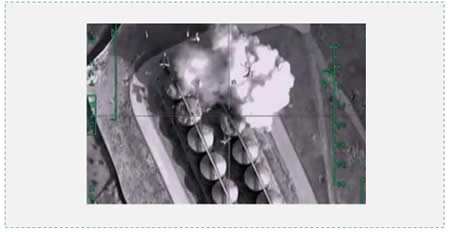
"Victory picture" of the Iraqi army: an Iraqi flag hung on police headquarters in the city of Ramadi in the Anbar Province (Al-Sumaria TV, December 28, 2015).
ISIS Loss of Territory in 2015 and the Causes
1. While 2014 was a year of conquest and expansion for ISIS, in 2015 it suffered a series of setbacks in Syria and Iraq, resulting in the loss of extensive areas under its control. Most important was the loss of Ramadi, the capital city of the Sunni Anbar Province, in Western Iraq. According to the spokesman of the Western anti-ISIS coalition, ISIS lost about 40% of the territory it had held in Iraq and 20% in Syria (Businessinsider.com). In addition, its oil production was hard hit, resulting in the loss of a substantial portion of its income from oil exports. ISIS also lost many fighters, including senior operatives, and its military infrastructures Iraq and Syria were damaged.
2. The following are the main areas previously under ISIS's control and lost primarily during the second half of 2015 (see the Appendices):
1) In Iraq the Iraqi army, with the support of Shi'ite and Sunni militias, retook a number of key cities and the regions around them: Ramadi (at the end of December), whose cleansing of ISIS operatives is not yet complete; Tikrit (April); Baiji (October). In addition, the Kurdish Peshmerga took the city of Sinjar and its surroundings (November). Fallujah, the jihadists' stronghold and symbol of power in Iraq, remains surrounded by the Iraqi army and isolated from ISIS backup and its main power base.
2) In Syria
A. The Kurdish forces, with aerial support from the United States and the coalition countries, took three important cities from ISIS: Kobanî (Ayn al-Arab) (January), Tel Abiad (June) and Al-Hasakah (end of July). That made it possible for the Kurds to establish an autonomous region in the northeastern part of Syria and create a territorial continuum along most of Syria's border with Turkey. Kurdish forces recently took control of the Tishreen Dam (December), which lies south of Kobanî, and its nearby power plant, depriving ISIS of an important economic asset.
B. In Aleppo and the surrounding regions the Syrian army lifted ISIS's siege of the Kuweyres military airport (November) and established itself in the rural area to the south of the city. Southeast of Homs the Syrian army took the town of Mheen (January 2016) and threatens the city of Al-Qaryatayn (captured by ISIS at the beginning of August). In the region north of Aleppo ISIS was weakened but is still active.
C. ISIS was also weakened in the Yarmouk refugee camp and the Damascus neighborhood of Al-Hajar al-Aswad, in the southern part of the city. At the end of December ISIS reached an agreement for the evacuation of its operatives under UN aegis, but the agreement has not yet been implemented. In the Al-Qalamoun region northwest of Damascus rebel organizations were weakened, ISIS among them. The ISIS-affiliated "Al-Yarmouk Martyrs Brigade" in the southern Golan Heights was also weakened.
3. The main causes of ISIS's loss of power and territory were most likely the following:
1) The increasing international efforts against ISIS, especially after Russia joined the campaign (although a considerable number of Russia's aerial attacks have targeted the rebel organizations in general, not just ISIS). In addition, after the terrorist attack in Paris, France and Britain began carrying out aerial attacks (November). Saudi Arabia, which formed and led a counter-terrorism coalition of 35 Arab-Muslim countries, will most likely also continue to increase pressure on ISIS. The intensive, ongoing aerial strikes have weakened ISIS's military capabilities (causing casualties and damaging its military infrastructure).
2) The military capabilities of the local forces in Iraq and Syria fighting ISIS have improved:
A) The Kurdish forces in Syria and Iraq (YPG and Peshmerga) have shown they possess good military capabilities and their morale is high. However, the (strategic) controversy between them and Turkey, an ally of the United States and the West, hampers the use of the Kurdish forces' potential to promote the campaign against ISIS.
B) The military capabilities of the Iraqi army improved, especially of their counter-terrorism task force, and its aerial and ground collaboration with the United States strengthened. Politically, the success of the Iraqi regime in recruiting militias from among the Sunni tribes in Anbar Province to support the Iraqi army also contributed to the victory in Ramadi (previously, Iranian-supported Shi'ite militias played a key role in taking over Sunni regions, which led to sectarian frictions).
C) The Syrian army's offensive capabilities also improved to a certain extent, thanks to intensive Russian aerial support and the ground involvement of Iran and Hezbollah: The most recent ground offensive was begun by the Syrian army three months ago (with the Iranians spearheading the attack and as a result suffering heavy losses). The result was a series of Syrian army successes to the south and east of Aleppo and south and east of Homs.
3) The blows to ISIS's income:
A) A strategic goal of Russia and the American-led coalition was to hit ISIS's sources of income. They attacked ISIS's oil production and marketing system, with intensive aerial strikes which increased in recent months. As a result, according to the American assessment, ISIS lost 40% of its oil revenues.
B) The United States is waging a multifaceted campaign against ISIS's financial system. It carried out targeted killings of senior figures in the organization's financial apparatus and attacked a building in the center of Mosul where ISIS stored large quantities of currency (used to pay its operatives and fund terrorist attacks). A senior official in the American Department of Defense said that millions of dollars in currency were destroyed (CNN, Agence France-Presse, January 11, 2016).
C) It is not yet clear to what extent the above-mentioned 40% drop in oil revenues has influenced ISIS's military and governmental capabilities, but most probably they will be influenced (such as ISIS's ability to recruit large numbers of new foreign fighters, replace its lost military infrastructure, and maintain the level of the services the Islamic State provides to the populations under its control).

Picture published by the Russian Ministry of Defense: the Russian air force strikes ISIS oil tanks in Syria (Tass, December 30, 2015).
4. Increased preventive measures taken by Turkey: In the past Turkey was a transit country for ISIS operatives on their way to Syria and a destination for the export of ISIS's petroleum products. After a long period during which Turkey turned a blind eye to ISIS's activities and did not take effective steps to prevent them, it began acting against ISIS (the result of both international pressure and ISIS terrorist attacks on Turkish soil). In recent months Turkey has increased the supervision of its border crossings and the routes leading to Syria, making it difficult for ISIS to exploit its logistic lifeline. However, the measures instituted so far have not been sufficiently effective and ISIS continues using Turkey as the main way station for its operatives and market for its petroleum exports (while carrying out terrorist attacks to deter Turkey from taking further action).
What Next?
5. Despite the loss of territories and the defeats suffered in Syria and Iraq, ISIS still controls extensive swathes of land and a large population in western Iraq and eastern Syria. The core of ISIS's power is Mosul in Iraq and Al-Raqqah in Syria. Even after its financial capabilities were damaged, ISIS remained the richest terrorist organization in the world. Its ideological appeal throughout the Arab-Muslim world has not waned. On the other hand, the foreign powers involved in Syria are not enthusiastic about sending a significant ground force to conquer ISIS's power bases, and the local organizations fighting ISIS also fight among themselves. In addition, the internal chaos in Iraq and Syria which allowed for ISIS's growth is not expected to undergo a fundamental change in the foreseeable future, so the ground remains fertile for ISIS activity in both countries.
6. Therefore, the pressure exerted on ISIS can be expected to continue degrading the organization but will not be able to destroy it. ISIS will probably look for strategic responses in the following fields:
1) In the military field: ISIS will continue taking the necessary steps to reduce the effects of the pressures on it, for example by moving forces from isolated or besieged areas where it is weak to its core areas (for instance, the agreement reached for evacuating ISIS operatives from south of Damascus); improving its defensive capabilities in the areas surrounding Mosul and Al-Raqqah; intensifying its guerilla warfare and terrorist attacks against the Iraqi army, the Syrian army, the Kurds and rival rebel organizations (including the use of suicide bombers); using mobile forces to carry out surprise raids in isolated areas to attack army forces and the civilian infrastructure and create the image of new victories and achievement (and leveraging them further in the media). ISIS can also be expected to continue minimizing its visible presence in cities and open areas to make it difficult for the Western and Russian coalition to carry out aerial strikes.
2) Making an effort to gain footholds and establish itself in other Arab-Muslim countries: It is probable that as pressure on ISIS increases in Iraq and Syria the organization will increase its efforts to establish itself in other countries and construct alternative arenas for its activities. Its top priority is apparently Libya, where during 2015 ISIS extended its territorial control of the region around Sirte. From its base in Sirte ISIS seeks to take control of regions to the east (the oil port of Sidr and the town of Ra's Lanuf, where Libya's oil industry is located), to the south (Libya's oilfields) and to the west (the capital city of Tripoli and the cities near it). Second on ISIS's list of priorities is probably the Sinai Peninsula, where its local branch is engaged in stubborn fighting with the Egyptian security forces (which have not succeeded in uprooting the ISIS operatives). ISIS will probably make an effort to extend its terrorist activities from the Sinai Peninsula to Egypt itself. Third on ISIS's list of priorities are probably countries and regions like Yemen, the Caucasus, and Afghanistan and Pakistan (Khorasan).
3) Increasing terrorism abroad: ISIS's weakening in Iraq and Syria was accompanied by an increase in terrorism abroad, including the attack in Paris, crashing the Russian plane and attacking Western tourists in hotels in Muslim countries (Tunisia, Egypt, Turkey and Indonesia). It can be assumed thatthe more blows ISIS suffers in Iraq and Syria, the greater its motivation will be to carry out attacks abroad to deter its enemies and try to preserve its image as victorious and the leading jihadist organization.[1] Countries likely to be in ISIS's crosshairs are the Western countries (especially in western Europe), Israel (recently the subject of an increasing number of ISIS threats), Russia and the Arab states participating in the campaign against ISIS (mainly Saudi Arabia). ISIS terrorist attacks abroad can be handled from Syria, Iraq and the Sinai Peninsula, or can be inspired by ISIS and carried out by its supporters in the Arab-Muslim world and in the Muslims communities in the West and other countries (including foreign fighters who returned to their countries of origin from Syria and Iraq).
7. Two appendices follow which summarize ISIS's loss of territory in Syria and Iraq in 2015.
[1]That may create a kind of "competition" between ISIS and Al-Qaeda, which was involved in terrorist attacks on hotels in Bamako, the capital of Mali, and Ouagadougou, the capital of Burkina Faso.






